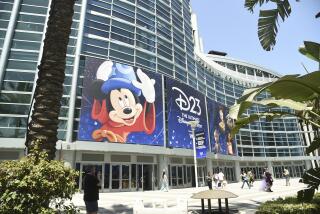Early Start on Disney Hall Project Was Calculated Risk : Building: Reliance on cost estimates, not contracts, is cited. County says it is not wedded to complex design.
- Share via
The clock was ticking loudly for the Disney Concert Hall in mid-1992. If construction did not begin by year’s end, the $50-million founding gift from Walt Disney’s widow would be withdrawn.
Since her original promise, planning for the new home of the Los Angeles Philharmonic had consumed nearly five years. So officials took what they now concede was a gamble.
To meet Lillian Disney’s deadline, they started building the project’s underground garage before detailed drawings and the total costs for the hall were finalized. This so-called fast-tracking meant that officials had to rely on a $210-million estimate, not on signed construction contracts, to erect the avant-garde design by Frank O. Gehry.
This week, that tactic’s true risks became painfully apparent with the announcement that Disney Hall will cost an estimated $50 million more, potentially jeopardizing what has been described as one of the nation’s most important cultural and architectural undertakings.
“That was a risk we were aware of,” said Frederick M. Nicholas, chairman of the Walt Disney Hall Committee. “We had to do that or else we wouldn’t get the gift, and we didn’t want to lose the gift.”
Like the rest of the Music Center on Downtown’s Bunker Hill, Disney Hall is to be built on county-owned land. The garage, under construction, is being funded with a $110-million county bond issue.
Los Angeles County officials now say they will not allow construction of the hall until final, guaranteed costs are determined and 95% of the money is pledged.
Nicholas and other Disney Hall supporters say they are confident that the extra money can be raised, and the Disney family has said it remains committed to the present design.
However, the county’s representative on the project, attorney Richard S. Volpert, said the county is not wedded to the complex and costly design, an undulating structure of white limestone, glass and steel that has been likened to a sailing ship.
“If you throw enough money at it, you can build an atom bomb, fly to the moon, build the Disney Concert Hall,” Volpert said.
Architecture and construction experts nationwide say that fast-tracking is a fairly common and useful practice that can save time and money. But it can backfire, they stressed, especially if the design is as unusual as Gehry’s. State-of-the-art computer technology is being used to help shape the curved materials for the 2,380-seat, wood-lined concert hall and its exterior.
Told of the Disney Hall situation, Bruce Vogelsinger, vice president of the National Institute of Building Sciences in Washington, said: “It sounds like that’s one of the risks they took and they lost.”
Disney family attorney Ron Gother defended the 1992 decision to proceed, noting that four separate cost estimates were “all within a few pennies of each other.”
“There was built into the budget ample reserves,” he said. “It didn’t seem as risky in 1992 as hindsight would say now.”
When Music Center officials revealed the increased costs Monday, they attributed much of the rise to the Northridge quake.
They later acknowledged, in response to Times inquiries, that heightened seismic safety standards for steel construction account for less than $2 million of the $50 million rise.
They continue to maintain, however, that urgent earthquake repair work elsewhere has drawn potential contractors away from what would normally be a plum job on a landmark building. Industry sources are divided on whether that had much impact.
A Music Center letter to county Supervisor Ed Edelman this week repeatedly refers to design complexities as a major cause of cost inflation.
Disney Hall officials said they looked into a simpler Gehry design of boxy structures, but decided that it would not save much money, given all that has already been spent on the current architectural goals.
“The decision has been made now that we go with the hall because of what it means to the city, and the fact that it’s a spectacular, unbelievable design,” said Nicholas, who volunteers as head of the Disney Hall effort. “This city needs this design. It needs this hall.”
Gehry’s office said the architect was en route to France and unavailable for comment Friday. His associate James Glymph, who is working closely on the project, said many other concert halls have had problems in establishing firm costs.
But Glymph stressed that Disney Hall delays were the main cause for the cost overruns. Groundbreaking for the Downtown concert hall garage was stalled for three years by complicated negotiations with the county and acoustical considerations that caused numerous redesigns.
Glymph said he hoped that contractors would lower their bids when they see the detailed drawings being prepared by another firm. “Anytime you engage in something unique, it is extremely important that a comfort level be out there in the marketplace,” he added.
Other sources familiar with the project said problems were worsened by the cumbersome nature of decision making for the concert hall.
Besides the county, the Disney family, Music Hall officials and Gehry, the cast includes Dworsky Associates, the architectural firm that is responsible for the detailed drawings and oversight; a construction consortium of three companies; a separate acoustics firm, and several other management and consulting entities. Also involved were the orchestra’s managing director, Ernest Fleischmann, and music director Esa-Pekka Salonen.
Disney Hall officials said they expected cost overruns of $4 million to $6 million and insisted they were surprised two months ago to learn of the $50-million increase.
According to committee budgets, some of the biggest increases in construction and material costs were in the steel framing, $8.6 million more than originally thought; in wood purchases and millwork, up $7 million, partly because of a decision to add interior wood; and in drywalling and plaster, up $4.9 million.
“The drywall designed for this hall has curves and movement that don’t have any comparison to anything else that’s been built in this city,” Nicholas said. “The people who were bidding the drywall had never seen anything like it, hadn’t had any experience with it. So they put a lot of contingencies in it and they bid it very, very high.”
A bright spot is the purchasing, cutting and installation of the exterior Italian limestone--a process Gehry has closely supervised. Bids on that stonework are reported to be $325,000 below its original $22.6-million estimate.
Meanwhile, professional and consulting fees have soared $16.3 million, to $56.5 million. Included in that figure are fees to the Gehry office, now estimated at $7.1 million, up $1.5 million. That is dwarfed by the sum for the Dworsky office, which is expected to have billings of $19.1 million, $7.3 million more than estimated.
Other items contributed to the $50-million rise, including $10 million for emergencies and contingencies.
Prabodh V. Banavalkar of CBM Engineering in Houston, the structural engineer in charge of Disney Concert Hall, described the Gehry design as “absolutely buildable.” He stressed that architects have done an excellent job of using computer programs to detail construction methods. That, he said, “should minimize or limit the factor of fear and get a better price for the project.”
Still, he added, “anytime you are exploring some new areas, you are breaking new ground, that exposure is always there. Columbus, when he started, didn’t know where he was going.”
When the original $50-million gift was announced in 1987, a deadline of five years seemed more than adequate, officials said. When it crept up, Nicholas recalled, “we didn’t go back to Mrs. Disney and say: ‘Will you extend that term,’ because we were embarrassed. We had taken so damn long.”
Through accrued interest and additional gifts, the Disney family’s total contributions to the hall have grown to $93 million.
In a statement this week, Lillian Disney pledged continuing support, but she did not come forward with any additional gifts. Her representatives stress, however, that they have not established another groundbreaking deadline and are certain current problems can be overcome.
“The building will be built, it’s just a question of when,” said Disney attorney Gother.
More to Read
The biggest entertainment stories
Get our big stories about Hollywood, film, television, music, arts, culture and more right in your inbox as soon as they publish.
You may occasionally receive promotional content from the Los Angeles Times.











